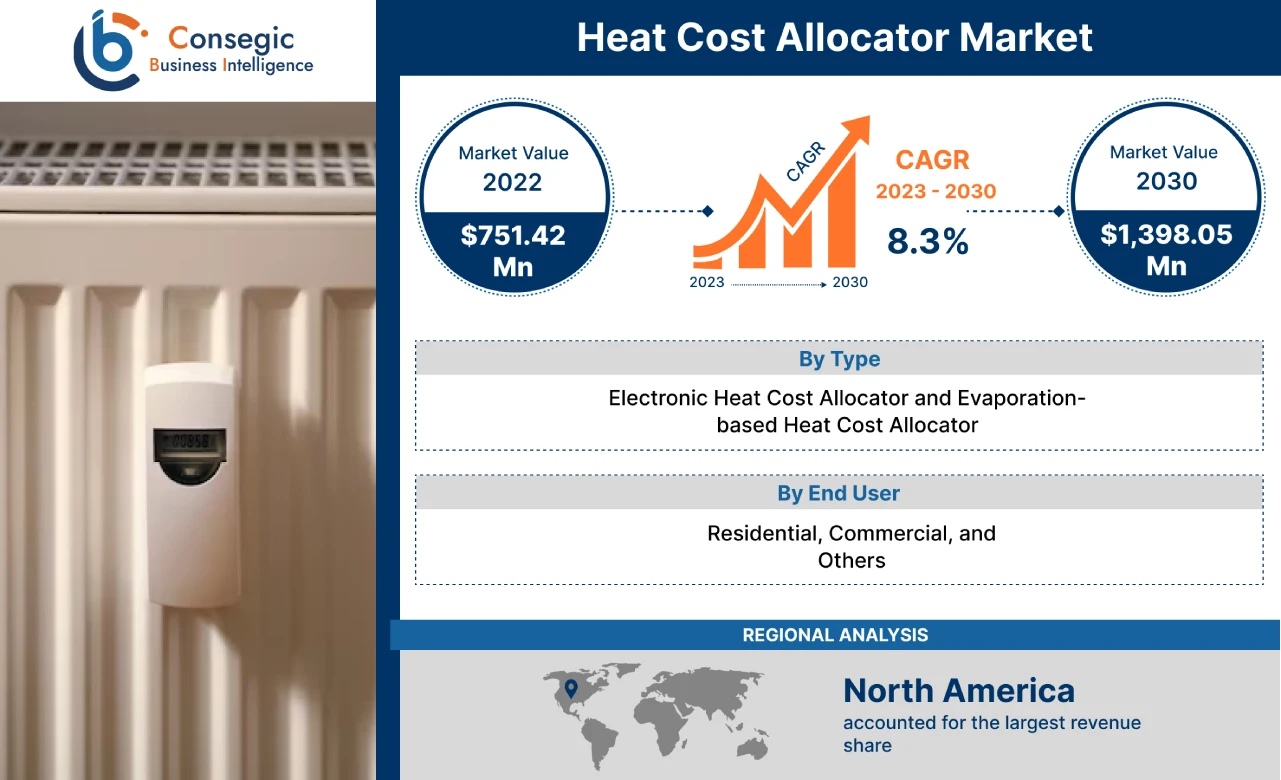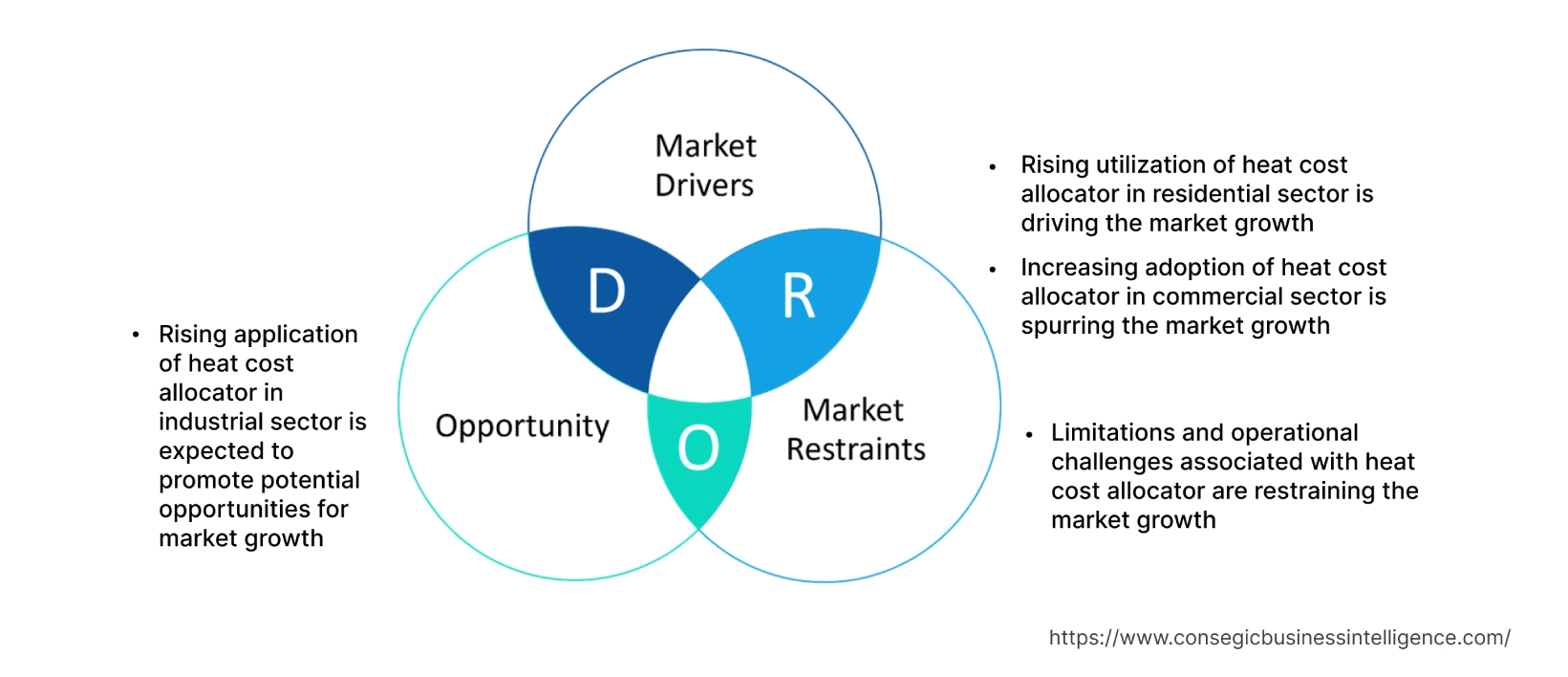- Summary
- Table Of Content
- Methodology
Heat Cost Allocator Market Introduction :
Heat Cost Allocator Market is estimated to reach over USD 1,398.05 Million by 2030 from a value of USD 751.42 Million in 2022, growing at a CAGR of 8.3% from 2023 to 2030.
Heat Cost Allocator Market Definition & Overview:
Heat cost allocator refers to a device that is attached to individual radiator in buildings and utilized for measuring the total heat output. A heat cost allocator estimates heat consumption by measuring the difference in temperature between the room and radiator with data that is wirelessly transmitted to a central unit. Moreover, heat cost allocator is capable of optimally allocating heat cost based on usage and display consumption values in an easily readable and user-friendly manner. The aforementioned benefits of heat cost allocator are key determinants for increasing its utilization in residential and commercial sectors among others.
Heat Cost Allocator Market Insights :
Key Drivers :
Rising utilization of heat cost allocator in residential sector is driving the market growth
Heat cost allocators are used in residential buildings for optimum allocation of heat cost based on consumption value. Heat cost allocators are applied to convectors and radiators installed in residential buildings for measuring user heat consumption in buildings with centralized systems that feature vertical heating distribution. The benefits of heat cost allocators including high reliability, ease of installation, longer shelf-life, and automatic measurement of consumption value are key determinants for driving its utilization in residential buildings.
Factors including the rise in disposable income, increasing investments, and government policies including tax incentives, subsidies, and rebates are among the key prospects driving the growth of the residential sector.
For instance, in 2022, the Government of the United Kingdom introduced a home-building fund to support new residential development in the country. The UK government provides direct investments ranging from USD 2.5 million to USD 6.2 million to residential builders in the country. Hence, the rise in residential construction is further driving the adoption of heat cost allocators for installation in residential buildings to measure heat consumption in buildings, in turn proliferating the growth of the market.
Increasing adoption of heat cost allocator in commercial sector is spurring the market growth
Heat cost allocators are utilized in commercial buildings, in integration with building radiators to measure total heat consumption in the building in a cost-effective manner. The ability of heat cost allocators to measure consumption value automatically through a communication unit is a prime aspect for increasing its adoption in commercial buildings.
Factors including rising commercial construction and increasing government initiatives for the installation of advanced heat metering systems are among the major determinants driving the adoption of heat cost allocators.
According to CoreLogic Inc., the total sales of commercial property in the United States witnessed considerable growth in 2021. The sales of commercial properties including offices, hotel, retail, and others increased by 16% during the second quarter of 2021 in comparison to 2019. Thus, the growth of commercial sector is further driving the deployment of heat cost allocators, owing to the above benefits, in turn driving the growth of the market.
Key Restraints :
Limitations and operational challenges associated with heat cost allocator are restraining the market growth
Heat cost allocators are usually associated with certain limitations and operational challenges, which is a prime factor restricting the growth of the market.
For instance, heat cost allocators are not capable of detecting changes in thermal properties of a radiator installed in a building when air accumulates in the inner-upper part of the radiator, specifically during winter seasons. Moreover, heat cost allocators are incapable of identifying whether its external temperature sensor is measuring the air temperature of the room, or the warm microclimate formation induced by the presence of curtains in front of the radiator. Heat cost allocators are also more prone to wrong positioning in radiators, which causes systematic errors in output readings.
Additionally, heat cost allocators are incompatible with floor heating systems and flat surface radiators among others. Hence, the aforementioned limitations and operational challenges associated with heat cost radiators are restraining the growth of the market.
Future Opportunities :
Rising application of heat cost allocator in industrial sector is expected to promote potential opportunities for market growth
The rising application of heat cost allocators in the industrial sector is expected to present potential opportunities for the growth of the heat cost allocator market. Heat cost allocators are often employed in the industrial sector, particularly in industrial plants and facilities to measure the total heat output of individual radiators installed in industrial buildings.
Factors including the rapid pace of industrialization and rising investments in the expansion of industrial facilities are key determinants for driving the growth of the industrial sector.
For instance, in March 2022, Kerry Group, a food and beverage company, launched its new food manufacturing facility with an investment of USD 137 million in Georgia, United States. Therefore, the rising development of industrial facilities is projected to increase the integration of heat cost allocators, in turn promoting opportunities for market growth during the forecast period.
Heat Cost Allocator Market Report Insights :
| Report Attributes | Report Details |
| Study Timeline | 2017-2030 |
| Market Size in 2030 | USD 1,398.05 Million |
| CAGR (2023-2030) | 8.3% |
| By Type | Electronic Heat Cost Allocator and Evaporation-based Heat Cost Allocator |
| By End User | Residential, Commercial, and Others |
| By Region | North America, Europe, Asia-Pacific, Latin America, and Middle East & Africa |
| Key Players | Techem GmbH, Itron Inc., Brunata Ltd., ZENNER International GmbH & Co. KG, Sontex SA, Siemens Switzerland Ltd., Engelmann Sensor GmbH, Te-sa s.r.l., Caleffi S.p.a., and Ista Energy Solutions Limited. |
Heat Cost Allocator Market Segmental Analysis :
Based on the Type :
Based on the type, the market is bifurcated into electronic heat cost allocator and evaporation-based heat cost allocator. The electronic heat cost allocator segment accounted for the largest revenue share in the year 2022. Electronic heat cost allocators are designed for decentralized installation and utilized when heating costs must be allocated to various consumers based on actual consumption. In an electronic heat cost allocator, temperatures are acquired by one or two sensors. In two-sensor mode, the actual difference in temperature between the room and radiator is attained, whereas a constant value for the room temperature is predefined in one-sensor mode. The measured values are further utilized as the basis for calculating consumption in electronic heat cost allocators. Moreover, electronic heat cost allocators are primarily used in the residential sector among others.
According to the Building and Construction Authority of Singapore, the total construction demand including residential construction in Singapore is estimated to reach between USD 27 billion to USD 32 billion by the end of 2023, demonstrating a significant growth in comparison to 2020. Hence, the rise in residential construction is driving the installation of heat cost allocators for measuring heat consumption in residential buildings, in turn contributing to market growth during the forecast period.
The evaporation-based heat cost allocator segment is anticipated to register significant CAGR growth during the forecast period. Evaporation-based heat cost allocators utilize a specific calibrated liquid in a capillary tube for recording the total heat absorbed from the air, in addition to the output generated by the radiator. Moreover, evaporation-based heat cost allocators offer several benefits including flexibility in parameter setting, simpler installation and commissioning, and improved operational efficiency, which makes it ideal for utilization in residential and commercial buildings among others.
For instance, according to the State of Nevada, U.S., the new residential building permits in Nevada reached 23,406 units in 2021, depicting an increase of nearly 19% as compared to 19,716 units in 2020. Thus, the rise in residential construction is further fostering the demand for evaporation-based heat cost allocators, owing to its above-mentioned benefits, in turn driving the market growth during the forecast period.
Based on the End-User :
Based on the end user, the market is segregated into residential, commercial, and others. The residential segment accounted for the largest revenue share of 51.5% in the year 2022. Factors including the rise in disposable income, growing residential construction, and the increasing deployment of heat metering systems for improved energy efficiency are among the key prospects driving the growth of the residential segment.
According to CoreLogic Inc., the sales of multi-family residential property in the United States witnessed significant growth of 26% during the second quarter of 2021 as compared to 2019. Therefore, the growth of residential sector is driving the utilization of heat cost allocators, attributing to its high reliability, flexibility in parameter setting, simpler installation, user-friendly interface, and versatility in display of heat consumption data. The above factors are anticipated to boost market growth during the forecast period.
The commercial segment is expected to witness the fastest CAGR growth during the forecast period. The growth of the commercial segment is attributed to several factors including the growing pace of urbanization, rising commercial construction, and increasing government initiatives for the installation of advanced heat metering systems. For instance, according to the UK Office for National Statistics, the new private commercial construction orders in the United Kingdom were valued at USD 4,295.1 million during the fourth quarter of 2022, witnessing an increase of 5.5% in comparison to the fourth quarter of 2019. Therefore, the rise in commercial construction is driving the adoption of heat cost allocators to measure total heat consumption of commercial buildings, in turn driving the growth of the market.
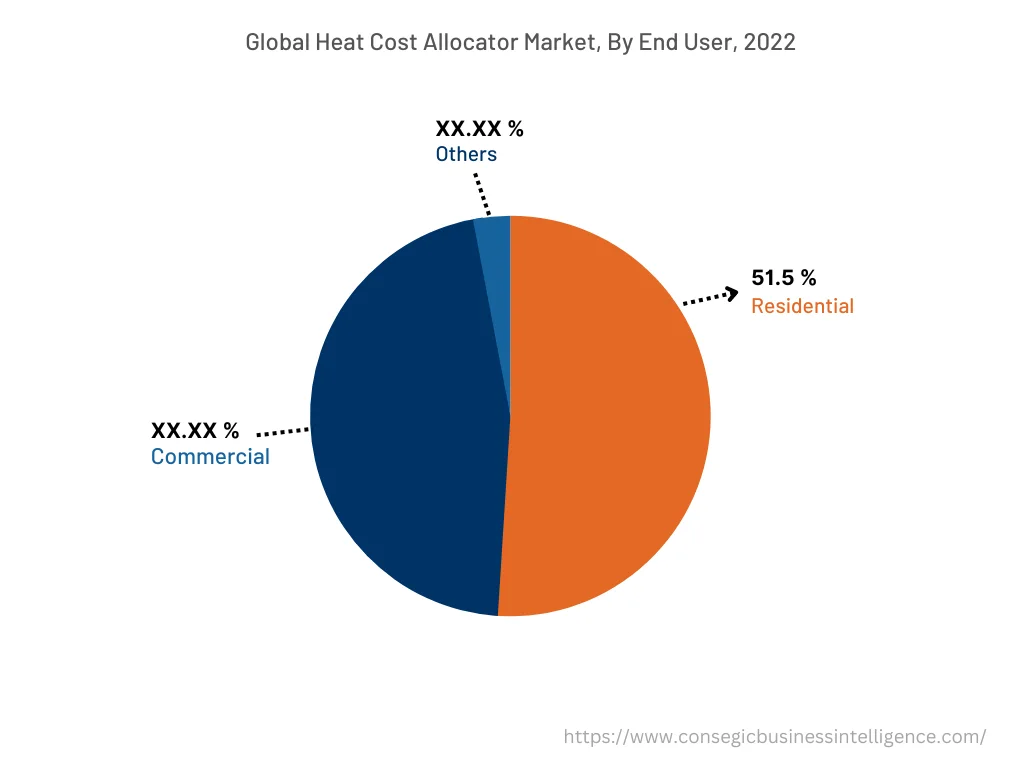
Based on the Region :
The regional segment includes North America, Europe, Asia Pacific, Middle East and Africa, and Latin America.
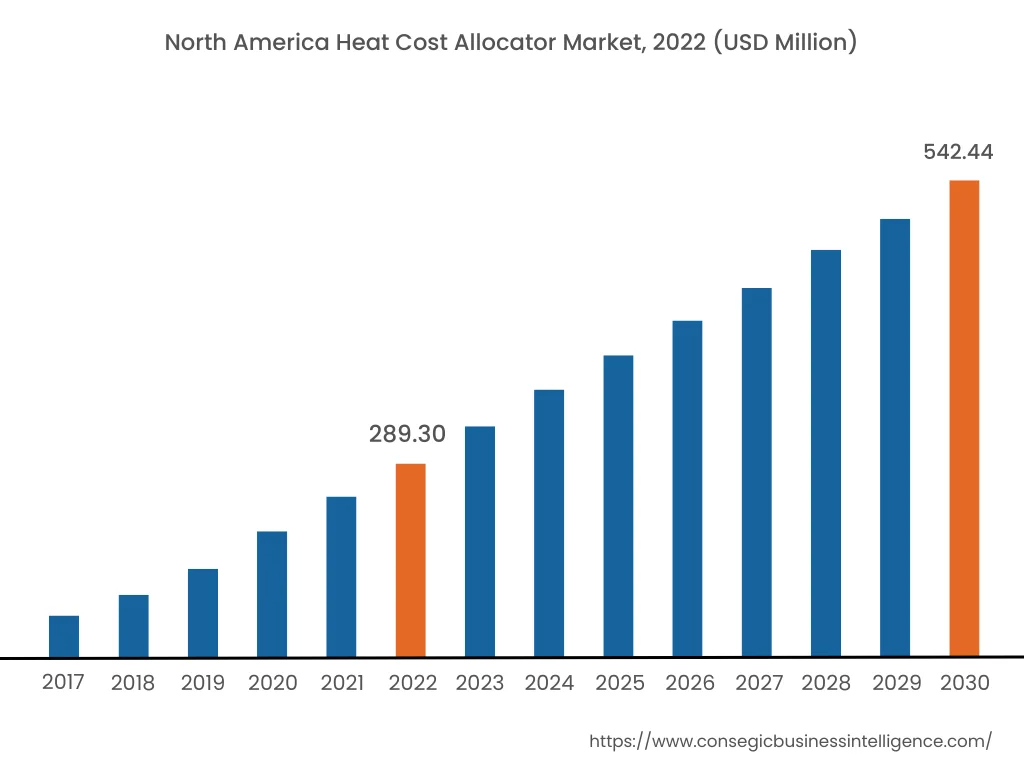
North America accounted for the largest revenue share of USD 289.30 Million in 2022 and is expected to reach USD 542.44 Million by 2030, registering a CAGR of 8.4% during the forecast period. In addition, in the region, the U.S. accounted for the maximum revenue share of 48.5% in the same year. The adoption of heat cost allocators in North America is primarily driven by multiple factors including rising investments in building and construction projects and increasing installation of heat metering systems in residential and commercial buildings in the region. For instance, according to Statistics Canada, investments in the building & construction sector reached USD 20.4 billion in January 2023, representing an increase of 1.5% in comparison to the previous year. Moreover, investments in the residential sector in Canada increased by 1.9% to USD 14.9 billion, while the non-residential sector increased by 0.5% to USD 5.6 billion in January 2023. The above factors are anticipated to drive the adoption of heat cost allocators in residential and commercial buildings, in turn driving market growth in North America during the forecast period.
Asia-Pacific is expected to register the fastest CAGR growth of 8.6% during the forecast period. The rapid pace of urbanization, industrialization, and development is creating lucrative opportunities for market growth in the region. Moreover, the rising government initiatives for the development of smart cities in the Asia-Pacific region are contributing to the market growth for heat cost allocator. For instance, the government of China launched multiple initiatives including China's 14th five-year Development Plan (2021 to 2025), National New-type Urbanization Plan, and smart cities projects with the aim of supporting the development of smart homes in the country. Additionally, several factors including the rise in commercial and industrial construction and growing need for automated heat metering solutions are further driving the demand for heat cost allocator in the Asia-Pacific region.
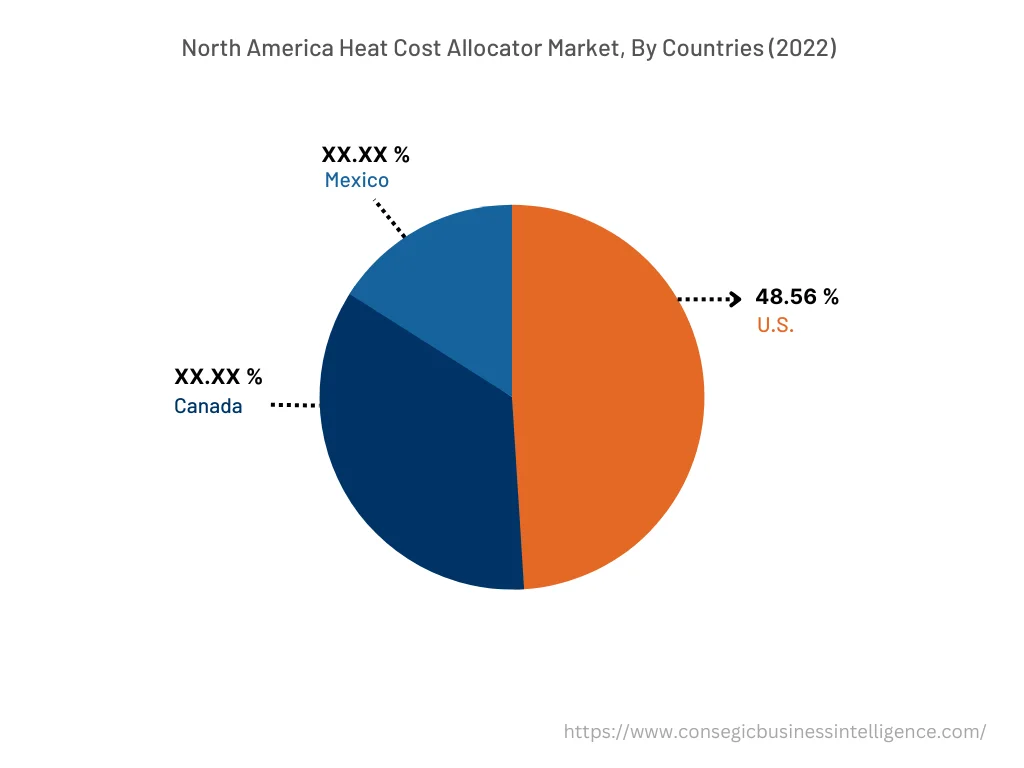
Top Key Players & Market Share Insights:
The heat cost allocator market is highly competitive with major players providing heat cost allocator to the national and international markets. Key players are adopting several strategies in research and development (R&D), product innovation, and application launches to hold a strong position in heat cost allocator market. Key players in the heat cost allocator market include-
- Techem GmbH
- Itron Inc.
- Te-sa s.r.l.
- Caleffi S.p.a.
- Ista Energy Solutions Limited
- Brunata Ltd.
- ZENNER International GmbH & Co. KG
- Sontex SA
- Siemens Switzerland Ltd.
- Engelmann Sensor GmbH
Key Questions Answered in the Report
What is heat cost allocator? +
Heat cost allocators refer to devices that are attached to individual radiators in buildings and utilized for measuring the total heat output of individual radiators.
What specific segmentation details are covered in the heat cost allocator report, and how is the dominating segment impacting the market growth? +
By type segment has witnessed electronic heat cost allocator as the dominating segment in the year 2022, owing to its increasing utilization in residential buildings among others.
What specific segmentation details are covered in the heat cost allocator market report, and how is the fastest segment anticipated to impact the market growth? +
By end user segment has witnessed commercial as the fastest-growing segment during the forecast period due to rising commercial construction and increasing installation of advanced heat metering systems in commercial buildings.
Which region/country is anticipated to witness the highest CAGR during the forecast period, 2023-2030? +
Asia-Pacific is anticipated to register fastest CAGR growth during the forecast period due to rapid pace of industrialization and rising building & construction projects in the region.
